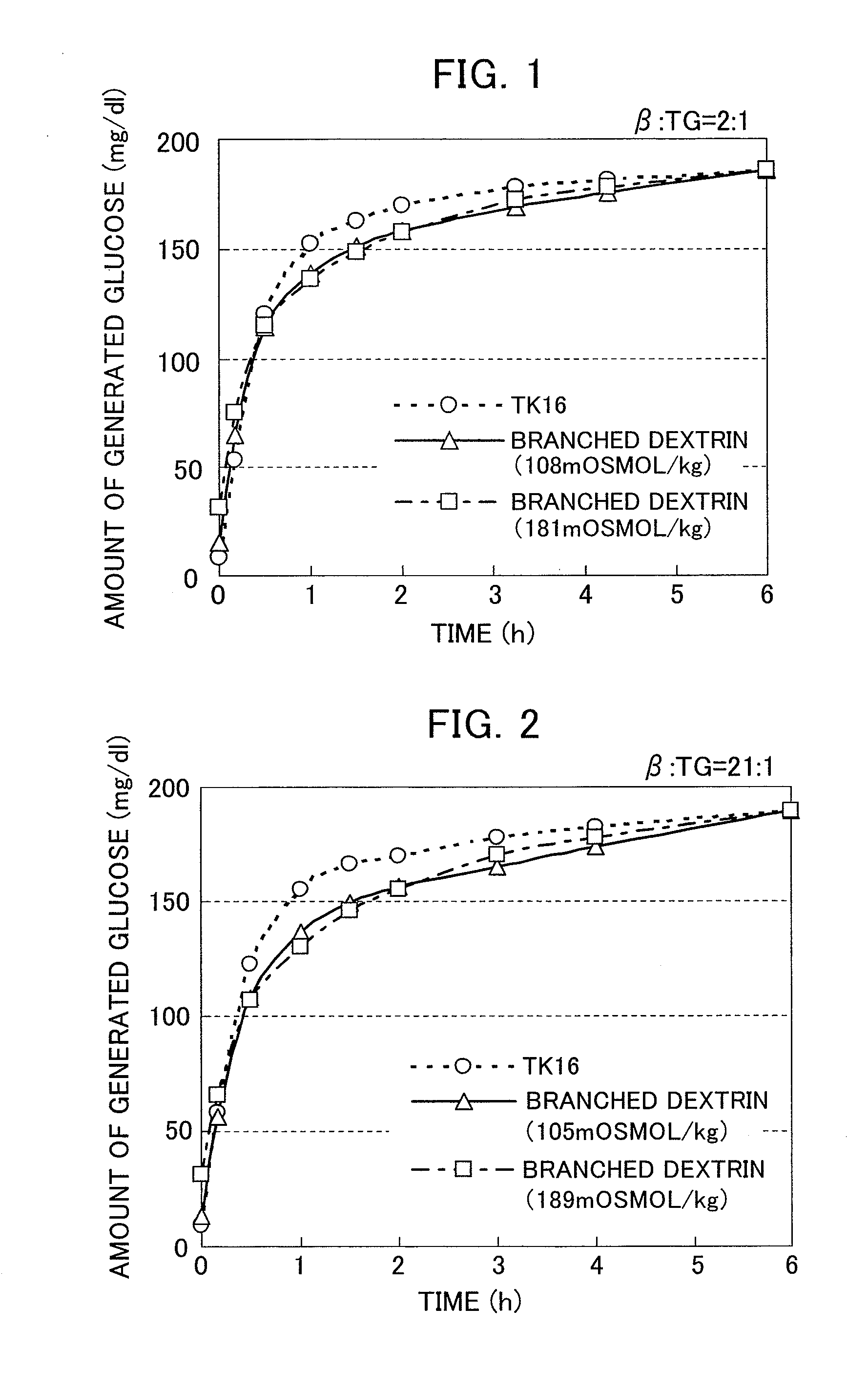Branched dextrin, process for production thereof, and food or beverage
a branched dextrin and process technology, applied in the field of branched dextrin, can solve the problems of inability, less than efficient method of production, and yield of highly branched dextrin obtained by this method of production, and achieve low glycemic index, low osmotic pressure, and low gi.
- Summary
- Abstract
- Description
- Claims
- Application Information
AI Technical Summary
Benefits of technology
Problems solved by technology
Method used
Image
Examples
example 1
Effect of Unit Ratio Between β-Amylase and Transglucosidase on Properties of Branched Dextrins
[0045]Dextrin (PDX#1: manufactured by Matsutani Chemical Industry Co., Ltd. / DE=8) (150 g) was dissolved in 150 g of a buffer solution (0.1 M phosphate buffer (pH 5.5)). 95 units of β-amylase (Biozyme ML: manufactured by Amano Enzyme Inc.) and 45 units of transglucosidase (transglucosidase L “Amano”: manufactured by Amano Enzyme Inc.) were simultaneously added to attain a condition with an enzyme unit ratio of 2:1 and a reaction was initiated at 55° C. 90 minutes and 180 minutes after the beginning of the reaction, a portion was sampled and kept individually at 95° C. for 15 minutes to terminate the reaction. The samples were individually filtered using diatomaceous earth and desalted using amphoteric ion-exchange resin (manufactured by Organo Corporation) to obtain branched dextrins with an osmotic pressure of 108 mOSMOL / kg and 181 mOSMOL / kg, respectively. (DEs thereof were 15.3 and 24.9, r...
example 2
Effect of Unit Ratio Between β-Amylase and Transglucosidase on Properties of Branched Dextrins
[0050]Dextrin (PDX#1: manufactured by Matsutani Chemical Industry Co., Ltd. / DE=8) (150 g) was dissolved in 150 g of a buffer solution (0.1 M phosphate buffer (pH 5.5)). 950 units of β-amylase (Biozyme ML: manufactured by Amano Enzyme Inc.) and 45 units of transglucosidase (transglucosidase L “Amano”: manufactured by Amano Enzyme Inc.) were simultaneously added to attain a condition with an enzyme unit ratio of 21:1 and a reaction was initiated at 55° C. 30 minutes and 180 minutes after the beginning of the reaction, a portion was sampled and kept individually at 95° C. for 15 minutes to terminate the reaction. The samples were individually filtered using diatomaceous earth and desalted using amphoteric ion-exchange resin (manufactured by Organo Corporation) to obtain branched dextrins with an osmotic pressure of 105 mOSMOL / kg and 189 mOSMOL / kg, respectively. (DEs thereof were 14.9 and 26.9,...
example 3
Effect of Unit Ratio Between β-Amylase and Transglucosidase on Properties of Branched Dextrins
[0052]Dextrin (PDX#1: manufactured by Matsutani Chemical Industry Co., Ltd. / DE=8) (150 g) was dissolved in 150 g of a buffer solution (0.1 M phosphate buffer (pH 5.5)). 1782 units of β-amylase (Biozyme ML: manufactured by Amano Enzyme Inc.) and 40.5 units of transglucosidase (transglucosidase L “Amano”: manufactured by Amano Enzyme Inc.) were simultaneously added to attain a condition with an enzyme unit ratio of 44:1 and a reaction was initiated at 55° C. 15 minutes and 90 minutes after the beginning of the reaction, a portion was sampled and kept individually at 95° C. for 15 minutes to terminate the reaction. The samples were individually filtered using diatomaceous earth and desalted using amphoteric ion-exchange resin (manufactured by Organo Corporation) to obtain branched dextrins with an osmotic pressure of 103 mOSMOL / kg and 178 mOSMOL / kg, respectively. (DEs thereof were 13.1 and 23....
PUM
| Property | Measurement | Unit |
|---|---|---|
| temperature | aaaaa | aaaaa |
| pH | aaaaa | aaaaa |
| temperature | aaaaa | aaaaa |
Abstract
Description
Claims
Application Information
 Login to View More
Login to View More - R&D
- Intellectual Property
- Life Sciences
- Materials
- Tech Scout
- Unparalleled Data Quality
- Higher Quality Content
- 60% Fewer Hallucinations
Browse by: Latest US Patents, China's latest patents, Technical Efficacy Thesaurus, Application Domain, Technology Topic, Popular Technical Reports.
© 2025 PatSnap. All rights reserved.Legal|Privacy policy|Modern Slavery Act Transparency Statement|Sitemap|About US| Contact US: help@patsnap.com



